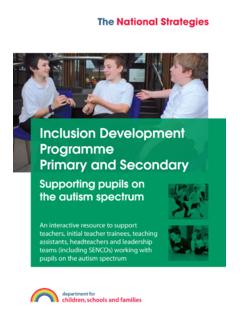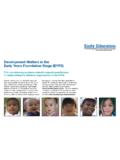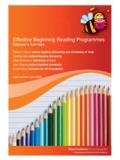Transcription of Inclusion Development Programme Primary and …
1 Inclusion Development Programme Primary and SecondarySupporting pupils with Behavioural, Emotional and Social DifficultiesMinimum specificationPCMacCPUP entium III or greaterPowerPC G4 (867 MHz or faster)RAM128 MB512 MBHard drive100 MB space100 MB spaceCD drive24 x speed24 x speedSVGA graphics card16 bit colour16 bit colourMinimum screen resolution1024 x 7681024 x 768 Sound card, speakers, or headphones16 bitStandardKeyboard and mouseYes (Microsoft compatible)YesOperating systemWindows 2000 or laterMac OS X or laterInstructions for running the diskInsert the DVD-ROM into your disk tray. Your computer may automatically run the program if you have a feature called Auto run enabled. If it does not automatically run, use the following steps. For PC users, select My Computer, and then select the disk icon to open. For Mac users, select the disk icon on your desktop to open. Select the file Flash Player requirementsThis product uses features in Adobe Flash Player version 9 and later.
2 You cannot use this product without this player. Download the latest version now Development Programme Primary and SecondarySupporting pupils with Behavioural, Emotional and Social DifficultiesFirst published in 2010 Ref: 00003-2010 BKT-ENDisclaimerThe Department for Children, Schools and Families wishes to make it clear that the Department and its agents accept no responsibility for the actual content of any materials suggested as information sources in this publication, whether these are in the form of printed publications or on a these materials, icons, logos, software products and websites are used for contextual and practical reasons. Their use should not be interpreted as an endorsement of particular companies or their websites referred to in these materials existed at the time of going to check all website references carefully to see if they have changed and substitute other references where PLANT 02-20101 The National Strategies Inclusion Development Programme : Primary and secondary Supporting pupils with BESD00003-2010 BKT-EN Crown copyright 2010 ContentsAbout the Inclusion Development Programme3 Introduction to the Inclusion Development Programme (IDP): Supporting pupils with Behavioural, Emotional and Social Difficulties (BESD)4 How to use this resource5 Key elements of effective CPD7 Structure of the course8 Module 1: How do BESD develop?
3 20 Module 2: How can I improve provision in the classroom for pupils with BESD?21 Module 3: How can I support individual pupils with BESD more effectively?23 Module 4: What are the other sources of support?243 The National Strategies Inclusion Development Programme : Primary and secondary Supporting pupils with BESD00003-2010 BKT-EN Crown copyright 2010 About the Inclusion Development ProgrammeThe Inclusion Development Programme (IDP) is part of the Government s strategy to improve outcomes for children with special educational needs and was first outlined in Removing Barriers to Achievement (0117-2004). It is a suite of materials aimed to support teachers, teaching assistants and trainee teachers to increase their knowledge and skills in working with children and young people with a range of special educational needs (SEN) so that their quality first teaching is even more effective and that aspirations for the outcomes for this group of pupils can be raised.
4 The IDP should not replace specialist knowledge; rather it is intended to support specialist advice and published IDP resources are: Inclusion Development Programme (IDP): Dyslexia and speech, language and communication needs (SLCN) An interactive resource to support headteachers, leadership teams, teachers and support staff (00070-2008 DVD-EN) Inclusion Development Programme : Supporting children with speech, language and communication needs: Guidance for practitioners in the Early Years Foundation Stage (00215-2008 BKT-EN) Primary and secondary Inclusion Development Programme (IDP): Supporting pupils on the autism spectrum (00041-2009 BKT-EN) Inclusion Development Programme (IDP): Supporting children on the autism spectrum: Guidance for practitioners in the Early Years Foundation Stage (00040-2009 BKT-EN)All of these resources may be found at the National Strategies web area, (Search for Inclusion Development Programme ).4 The National Strategies Inclusion Development Programme : Primary and secondary Supporting pupils with BESD00003-2010 BKT-EN Crown copyright 2010 Introduction to the Inclusion Development Programme (IDP): Supporting pupils with Behavioural, Emotional and Social Difficulties (BESD)The aims of this Programme are to: improve outcomes for pupils with BESD increase knowledge and understanding among professionals about the complex nature of BESD share good practice so that professionals in mainstream schools can make adjustments to their policies, practices, procedures and curriculum that will enable more young people with BESD to benefit from a mainstream National Strategies Inclusion Development Programme : Primary and secondary Supporting pupils with BESD00003-2010 BKT-EN Crown copyright 2010 How to use this resourceThe Primary and secondary Inclusion Development Programme (IDP).
5 Supporting pupils with Behavioural, Emotional and Social Difficulties (BESD) is available on DVD-ROM and on the National Strategies web area at (search using the reference00003-2010 EPD-EN-01). There is also an Early Years Foundation Stage (EYFS) IDP Programme , Supporting children with Behavioural, Emotional and Social Difficulties (BESD): Guidance for practitioners in the Early Years Foundation Stage. This resource has a handbook and accompanying DVD-ROM and may also be viewed on (search using the reference 00010-2010 EPD-EN-01).This resource may be used in a variety of ways and with a range of practitioners and professionals. It is not a resource to be used only by the special educational needs coordinator (SENCO) and the SEN support team, although it is recognised that the SENCO will be an important part of the leadership team which will drive and support the messages in the with all good professional Development , obtaining a baseline of existing skills and knowledge in the area before starting the Programme will allow professionals in local authorities, schools and initial teacher training programmes to measure any gains upon completion of the Programme and related activities which the local authority and school may wish to draw upon.
6 The self-evaluation checklist (file in the library) enables learners, headteachers, SENCOs and leadership teams to assess skills and knowledge that already exist in the area of BESD in their school. This should be completed before and after using the DVD or online materials. The initial baseline information could be used by the school to draw up an audit of existing skills and from this devise an action plan which can be personalised to suit the needs of the National Strategies Inclusion Development Programme : Primary and secondary Supporting pupils with BESD00003-2010 BKT-EN Crown copyright 2010 Using this resource via the webTo view this IDP resource on the National Strategies web area go to (search using the reference 00003-2010 EPD-EN-01). Before you begin you may find it useful to set up an IDP folder on the desktop of your personal computer. Here you can save key documents and set up a reflective learning journal which will allow you to record your learning as you National Strategies Inclusion Development Programme : Primary and secondary Supporting pupils with BESD00003-2010 BKT-EN Crown copyright 2010 Key elements of effective CPDThe IDP requires school practitioners to adopt a learning approach which is a blend of activities and contexts in order to sustain effective professional learning.
7 The following approaches have been found to be key to the transfer of deep learning: ownership and a belief that this is something worth learning clear goals and a sense of purpose (most effective when focused on goals that individual partners could not achieve alone) collaboration (as distinct from networking) adoption of coaching models, for example co-coaching, collaborative coaching and enquiry specialist instruction support from leadership (more powerful than the processes) monitoring and evaluation achievable ways of measuring success.(Ref: Transferring Learning and Taking Innovation to Scale, Cordingley, P. and Bell, M. (2009), Centre for the Use of Research & Evidence in Education: )Effective CPD is likely to have a direct relationship with what teachers are doing in their own schools and classrooms, uses external expertise linked to school-based activity and involves observation and feedback (especially teachers observing and learning from each other and from expert colleagues).
8 This course has been structured around a scenario which involves colleagues from both Primary and secondary schools reflecting on their practice and sharing their expertise so that colleagues may learn and develop in a supportive learning community. 8 The National Strategies Inclusion Development Programme : Primary and secondary Supporting pupils with BESD00003-2010 BKT-EN Crown copyright 2010 The e-learning materials and the video footage last approximately one-and-a-half hours; however, it is expected that schools will use the resource as part of their CPD to stimulate discussion about their policies and ethos in the way that they affect pupils with BESD. Structure of the courseThere are four areas of study. Each area addresses a key question which many new teachers and teaching assistants may wish to consider and which many more experienced colleagues may wish to revisit. The menu allows you to visit each of these questions in whichever order you prefer, but essentially each unit builds upon the previous one.
9 A collaborative enquiry approach, led by a knowledgeable and experienced practitioner, is essential if staff are to gain a deeper understanding of the key questions. The questions are: How do BESD develop? How can I improve provision for pupils with BESD in the classroom? How can I support individual pupils with BESD more effectively? What are the other sources of support? 9 The National Strategies Inclusion Development Programme : Primary and secondary Supporting pupils with BESD00003-2010 BKT-EN Crown copyright 2010 You will be introduced to a set of fictional characters and the questions are answered through a scenario approach. The situations are explored through a local area cluster meeting where a range of professionals meet to reflect upon approaches that they adopt when meeting the needs of pupils with BESD. The professionals from both Primary and secondary schools work in partnership to extend each other s understanding of you enter the course you will see a Start tab.
10 Select Start and you will have a choice to either select Start or skip to the you select Start you will see a short animation which invites you to consider the underlying factors which can cause BESD. You may like to view or show this animation with a group at the beginning of a professional Development you enter the modules there is a seven-screen introduction which sets the scene and gives you further information about how this resource might help you in your specific role. The roles identified in the What s in it for me? page are: classroom teacher teaching assistant school leader other following tabs can be accessed throughout the course: Library Glossary Help Exit Menu10 The National Strategies Inclusion Development Programme : Primary and secondary Supporting pupils with BESD00003-2010 BKT-EN Crown copyright 2010 The practitionersYou will be introduced to four practitioners who will share their concerns at a local cluster meeting: MandeepMandeep has been a Year 4 Primary school teacher for 18 months.







